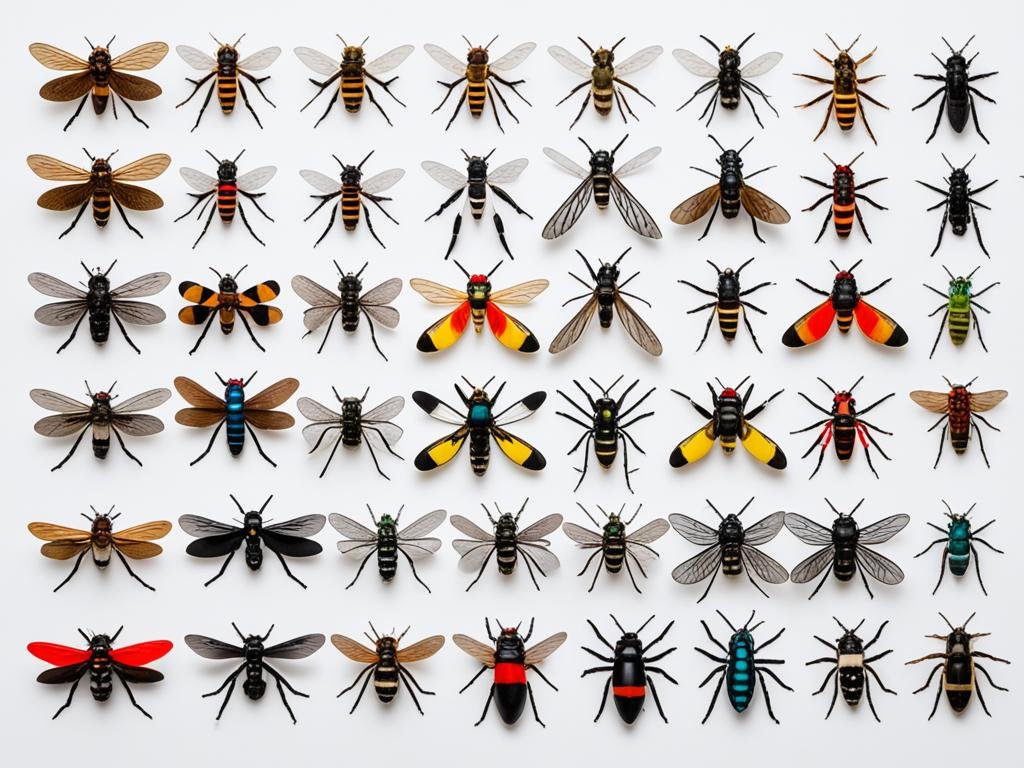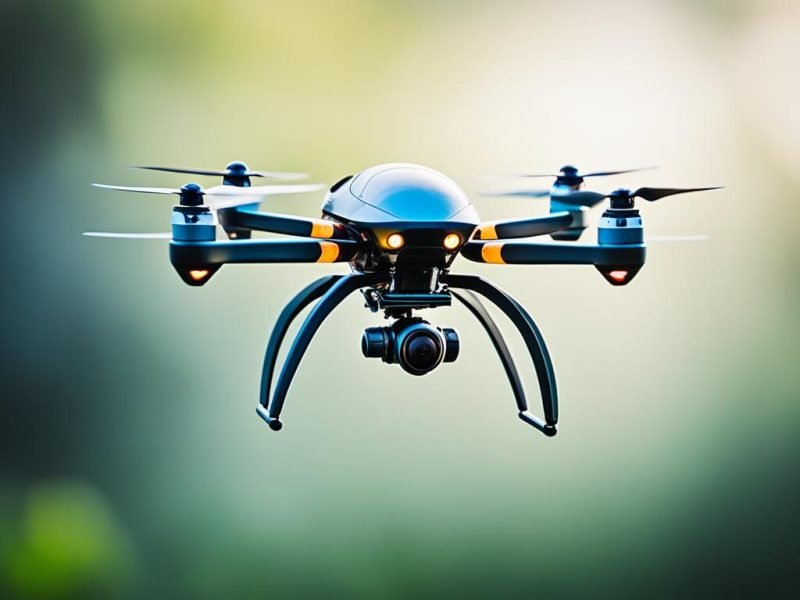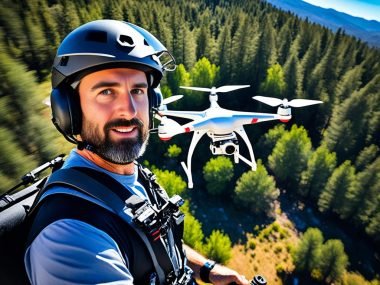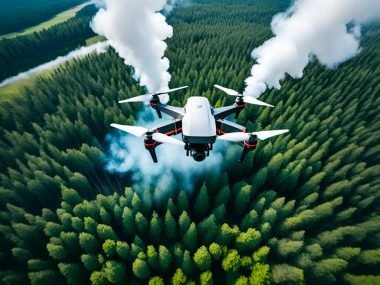In an age where it’s hard to tell fact from fiction, a shocking idea popped up. It was believed the U.S. military had made a “polymer drone” that looked exactly like a live fly. I talked to Gene Hall at the University of Arizona’s Insect Collection and Douglas Yanega at The Entomology Research Museum at the University of California, Riverside. They helped explain that the so-called “drone” was really a bot fly, from the Cuterebra genus.
The truth shows that, although drones like the Black Hornet are advanced, they can’t yet mimic real insects perfectly.
Exploring the topic of Are Drone Flies Real showed me how amazing and complex insects are. Nature has created wonders that our current tech cannot copy yet. The idea of secret, bug-like spy drones? For now, it’s just a myth. However, the potential and real uses of insect drones deserve a detailed look. This is aside from the myths that often overshadow them.
Key Takeaways
- Claims of a U.S. military “polymer drone” resembling a fly have been debunked by entomology experts.
- Real-life drone flies, such as the genus Cuterebra, show the intricate detail that drones like the Black Hornet have yet to replicate.
- Technology has not advanced to the point of creating drones that can fully mimic the flight patterns and appearance of true flies.
- Understanding the distinction between myths and drone flies facts is crucial in grasping the current landscape of drone technology.
- Insights from entomologists are invaluable for accurate identification and appreciation of the complexity within the insect world.
Unveiling the Truth About Drone Flies
In today’s tech-savvy world, it’s hard to tell fact from fiction. We hear a lot about drone flies and myths that follow them. I aim to clear the air with a simple drone fly identification guide for our readers.
Debunking the Viral Military Drone Fly Myth
A story that’s gotten a lot of attention is about a so-called military drone fly. This rumor started with a video that spread like wildfire online. Experts Gene Hall and Douglas Yanega proved it was actually a botfly, not a drone. Their work shows how important it is to check the facts.
Insect Drones vs. Real Flies: Examining the Facts
Yes, the military uses tiny drones like the Black Hornet. But these drones don’t try to look exactly like real flies. Alex Caccia explains how tough it is to copy how insects like dragonflies fly. The tech we have isn’t there to take over the roles of real drone flies.
Insights from Entomology Experts on Fly Identification
Experts in entomology are key to understanding real drone flies. They help bust myths and keep science accurate. Thanks to them, we can admire the botfly’s natural abilities, separate from tech drones’ aims.
Drone Fly Identification Guide
In my garden or a colorful meadow, I often stop to watch various pollinators at work. Among them, drone flies stand out with their amazing mimicry, particularly those from the Eristalis genus. Today, I plan to explore these interesting creatures further and highlight some drone flies facts. I’ll also offer a practical drone fly identification guide.
Identifying drone flies is both fascinating and useful. One must observe closely to see the subtle differences between these flies and bees. They move from flower to flower, just like bees do on their pollination quests. Spotting this behavior helps recognize these efficient pollinators.
Now, let’s focus on the visual signs that help us tell drone flies apart from other insects, especially the Eristalis species. Eristalis dimidiata looks similar to leaf cutter bees, and Eristalis flavipes resembles bumblebees with their fuzzy bodies. This mimicry is their strategy to avoid predators while pollinating.
- Look at the body shape and stripes to identify Eristalis drone flies. Pay extra attention to the abdomen’s colors and textures.
- Watch how the insect moves, checking if it has a consistent way of visiting flowers, which shows it’s a pollinator.
- Notice the wings’ structure and how they flap during flight. Even if subtle, these movements can help you know their true identity.
| Species | Resemblance | Distinguishing Features |
|---|---|---|
| Eristalis dimidiata | Leaf cutter bees | Yellow and black striped pattern, dense hairs but less than actual leaf cutters |
| Eristalis flavipes | Bumblebees | Fuzzy abdomen and thorax, but not as rounded as bumblebees |
| Eristalis tenax | Honeybees | Similar size and flight, but hovering behavior shows they are flies |
By following these drone fly identification guide tips, both newbies and pros can enjoy and learn from spotting these amazing insects. With careful observation and some practice, anyone can get good at identifying drone flies. This helps us appreciate these important pollinators even more.

Drone Flies in Nature: Understanding Their Role
Learning about drone flies in nature shows us their ecological importance. These creatures, looking a lot like bees and wasps, are important pollinators. They help plants grow which we need for food and our economy. Let’s explore how they make a big difference and the smart ways they’ve adapted to nature.
The Ecological Importance of Drone Flies as Pollinators
Drone flies from the Syrphidae family are seen around flowers, playing a vital role in pollination. They help ecosystems thrive and aid in growing key crops like coffee, chocolate, tea, plus fruits like bananas and mangoes. Their bodies pick up and spread pollen, helping plants reproduce.
Batesian Mimicry: How Drone Flies Fool Predators
The way drone flies trick predators is fascinating. They use Batesian mimicry to look like bees and wasps. This scares off enemies, even though drone flies can’t sting. This clever trick is a great example of nature’s balance between hunter and hunted.
Where to Find Drone Flies and Their Habitats
If you want to see these amazing insects, know where to look. You can find them in gardens, meadows, and untouched natural places. Female drone flies also collect pollen, not just nectar. Their habitats change with the seasons, from spring to autumn.
| Season | Drone Fly Activity | Typical Habitats |
|---|---|---|
| Spring | Emergence and foraging | Gardens and orchards |
| Summer | Pollen-collection peak | Meadows and grasslands |
| Fall | Preparation for overwintering | Forests and heathlands |
Studying drone flies’ migratory patterns and habitat preferences deepens our grasp of their role in ecology. They show the resilience and complexity of nature. They also support the ecosystems they live in. It’s our duty to watch and protect the balance they contribute to.
Distinguishing Drone Flies from Other Insects
Exploring the world of aerial mimicry is fascinating. I often get caught in the act of distinguishing drone flies from other insects. These smart little creatures master the art of disguise. They mimic the looks of bees. But, they are set apart by unique behaviors and biology.
The Eristalis tenax is one that I’ve watched closely. It not only looks like a honeybee but also copies its flight. This mimicry is nature’s clever trick. It makes distinguishing drone flies from other insects an interesting challenge.
To spot these fakes in a busy garden, look for specific signs. I have gathered these signs in a simple guide. It helps in distinguishing drone flies from other insects.
| Characteristic | Drone Fly | Other Insects |
|---|---|---|
| Antenna Length | Short | Variable, often longer |
| Body Hair | Dense, resembling a bee | Less dense or absent |
| Flight Pattern | Bee-like, hovering | Varies, often not bee-like |
| Eyes | Large, often touching | Smaller, usually separate |
| Behavior | Visits flowers, mimics bees | Diverse, not always flower visitors |
Continually observing drone flies is eye-opening. It builds a deep respect for life’s complexity. Identifying them is more than a task. It’s a tribute to nature’s diversity. Truly, it’s a privilege to learn the craft of distinguishing drone flies from other insects.
Conclusion
After a thorough investigation and talking to bug experts, I’ve clarified common misconceptions about drone flies. These interesting insects are actually part of the Syrphidae family. They play a key role in pollinating plants. It’s also clear that stories about U.S. military insect drones are just myths.
In exploring drone fly myths, we learned something important. The difference between real flies and tech ones is huge. The Black Hornet drone shows this well. It’s made for military use, not pollination.
We must always seek the truth, especially today when myths can easily spread. I hope this article has taught you something. And maybe now, you’ll see the insects in your garden in a new light. They’re important to our world.







